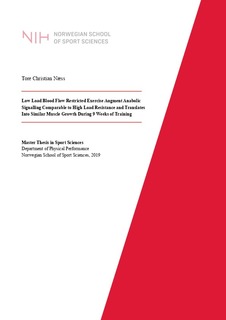| dc.description.abstract | Purpose: It is well established that high-load resistance training (HL-RT, >70%/1RM) activates mTORC1 and elevates muscle protein synthesis. In addition, evidence from the last decade point to the direction that lower mechanical loads (20-40% 1RM) combined with blood flow restriction (BFR-RT) can augment protein synthesis to a similar extent (Fry et al., 2010). Corresponding signalling pathways have been identified, however, no studies have directly compared the anabolic signalling succeeding a bout of BFR-RT vs. HL-RT. Thus, we aim to elucidate some of the anabolic signalling regulating muscle hypertrophy induced by BFR-RT compared to HL-RT.
Methods: Twenty-one strength trained males and females (24±3y) performed 9 weeks of lower body strength training (3/week) with either BFR-RT or HL-RT. Before and after the intervention, muscle mass was quantified with DEXA and MRI, and muscle function was assessed with MVIC of knee extensors. Biopsies were obtained from m. vastus lateralis before and 2, 24 and 48-h after the last exercise session.
Results: Quadriceps CSA increased after BFR-RT (7.4±4.3%, p<.001) and HL-RT (4.6±2.9%, p=.007) with no differences between groups (p=.152). HL-RT increased MVIC (9.7±12.2%, p=.030) whereas no significant changes were observed after BFR-RT (5.2±12.9%, p=.28); no group interaction (p=.416). Phosphorylation of p70S6KThr389 was elevated from baseline at 2-h (31-fold increase, p=.008) and 24-h (14.6-fold increase, p=.018) in HL-RT and elevated at 2-h (9.8-fold increase, p=.001) in BFR-RT, with no differences between groups (p=.826). Phosphorylation of rpS6Ser235/23 (p=.564) and 4E-BP1Thr37/46 (p=.474) was not different between HL-RT and BFR-RT at any time point. Phosphorylation of ERK1/2Thr202/Tyr204 increased from baseline at 24-h (65±53%, p=.009) in HL-RT and increased from baseline at 2-h (77±56%, p=.002) and 24-h (140±144%, p=.011) in BFR-RT, with no differences between groups (p=.563).
Conclusion: Overall, these data support the application of BFR-RT to induce hypertrophic adaptations comparable to HL-RT. In addition, our data suggest that the key anabolic signalling proteins driving the hypertrophic responses from BFR-RT and HL-RT are activated following an exercise bout of either training modalities. This suggests that the activation of the mTORC1 pathway along with ERK1/2 to be important as a potential underlying signalling pathway of BFR-RT induced muscle hypertrophy. Consequently, BFR-RT could be used to reduce external mechanical loading while inducing a potent anabolic response proceeding to muscle hypertrophy. | nb_NO |
